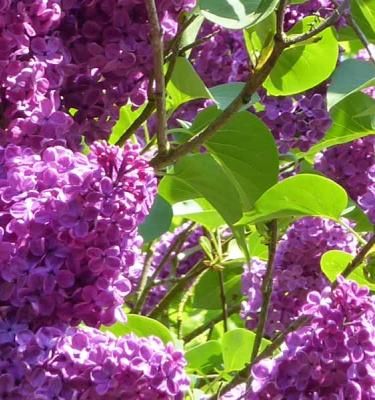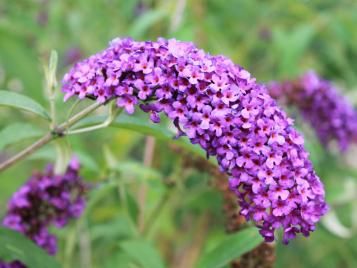

How to grow Buddleia
Commonly known as the butterfly bush, Buddleia davidii is a hardy, summer flowering shrub which is very easy to grow. All it needs is a sunny, open position and to be pruned hard in early spring. The plump nectar-rich flower spikes of this fast-growing deciduous shrub are very attractive to pollinators, especially butterflies. Deadhead regularly to encourage flowering all the way through to autumn.
Types of Buddleias to grow
Most Buddleias have pointed grey-green leaves and grow with an upright, arching habit. Try planting a few different Buddleias to keep the pollinators happy. Except where indicated these suggestions are varieties of Buddleia davidii:
- ‘Black Night’: a tall form (3m) with deep royal purple flowers and bright orange ‘eyes’ in the centre of each flower.
- ‘Nanho Purple’: a compact form for smaller gardens or a large patio container.
- ‘Buzz Sky Blue’: this is one of the compact Buzz series which are suitable for containers and small gardens. It grows to about 1.2m and bears bright blue mauve flowers in shorter spikes than some of the taller specimens. Other Buddleias in the Buzz series have pink or white flowers.
- Buddleia globosa: for something a bit different, this large shrub (up to 5m) has dense round clusters of orange yellow flowers giving it the common name of ‘Orange Ball Tree’.
- Buddleia alternifolia: mauve or pink flowers stud the length of the previous year’s stems. Train this specimen shrub against a wall or fence in full sun.

What you’ll need to grow Buddleia
Buddleia is best planted in the autumn or spring after frosts
If you plant your Buddleia in the summer, remember to keep watering it until it is established.
Buddleias grow in most types of soil as long as it is well drained. If your soil is heavy clay, introduce some horticultural grit into the planting hole to improve drainage. For more free-draining soils, add some well-rotted manure to the planting hole to enrich the soil and help to retain nutrients. The more compact forms of Buddleia can be planted in a large container, using peat-free shrub compost.
Where to plant and place your Buddleia
Plant Buddleia if you’re planning a wildlife garden. Choose a sunny site to plant your Buddleia where it has room for the arching branches to spread without interfering with neighbouring plants. Because the wood is rather brittle, it is wise to plant this shrub in a sheltered location to lessen the chance of wind damage.
Buddleias are relatively late flowering plants, tending to come into flower in the later summer months, when many other flowering shrubs have gone over. The taller varieties, such as Buddleia ‘Black Night’ can be grown either as specimens in a prominent position in the garden or at the back of a mixed border. Make sure you can get to the plant to be able to prune it in early spring. This encourages the Buddleia to put on new growth rapidly, on which this year’s flowers will appear.
Caring for and nurturing your Buddleia
Follow these tips to get the best from this handsome, wildlife friendly shrub:
- Plant in a sunny position.
- Grow it in well-drained soil.
- Buddleia davidii can withstand cold winters. Protect more tender varieties with horticultural fleece in the winter months and if it’s growing in a container, move it into a greenhouse or conservatory.
- Remove the brown spent flowerheads to improve the appearance of the shrub and to encourage a second flush of slightly smaller flowers.
- Water newly planted Buddleias for about 18 months after planting. To conserve moisture, apply a 5cm mulch in early spring.
- Other than an annual application of mulch, plants grown in reasonably fertile soil don’t need additional feeding. Feed container grown Buddleias with an annual application of continuous release fertiliser or, from April to October, water in liquid fertiliser.
- In early spring prune to 90cm or less.
- Propagate Buddleia by taking softwood cuttings in early summer, or semi-ripe cuttings later in the summer. Cuttings root fairly easily and should be ready to plant out after about two years.
- Repot Buddleia in containers every 3 years to stop it from getting root-bound, using peat-free multi-purpose compost.
Common pests and diseases with Buddleia
Buddleia can be affected by:
- Capsid bug, which damages the leaf tips.
- Figwort weevil, which also distorts the leaf tips.
- Earwigs, which nibble the flowers.
How can I get rid of capsid bug?
Encourage natural predators into the garden to control the population of the bugs or spray the affected parts of the plant with BugClear Ultra, following the manufacturer’s instructions.
How can I get rid of figwort weevil?
You can get rid of figwort weevil using the same method as for capsid bug.
What can I do about earwigs on my Buddleia?
Make an earwig trap by stuffing an inverted paper cup with straw. This provides a daytime shelter for the earwigs which can be removed. Earwigs are excellent at eating aphids, so you might want to move them to a different part of the garden, rather than destroy them.
Frequently asked questions about Buddleia
When should I prune Buddleia?
You should prune Buddleia in early spring, to less than 90cm.
When does Buddleia flower?
Most varieties flower throughout the summer, from June until the autumn.
Is Buddleia poisonous?
No Buddleia isn’t poisonous.
Does Buddleia take long to grow?
No, Buddleia is a very fast growing plant and can be cut back every spring to encourage the growth of new stems.
Key features of Buddleia
| Botanical Name | Buddleia davidii |
|---|---|
| Plant Type | Deciduous shrub |
| Family | Scrophulariaceae |
| Light Exposure | Sunny position |
| Soil pH | Any |
| Flowering Time | Summer and autumn |
| Flower Colour | White, pink, mauve, purple |



